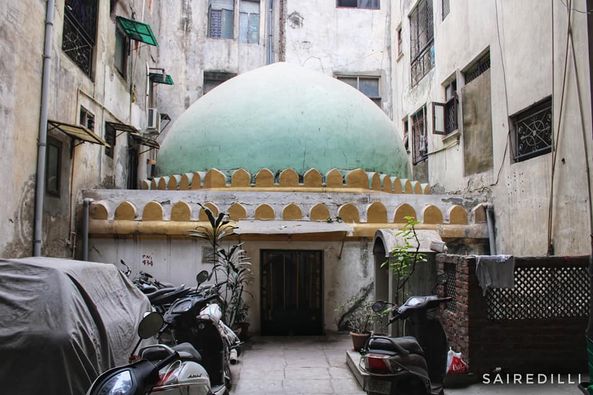
Dargah Hazrat Usman Saiyyah
Dargah of Hazrat Usman Saiyyah: Echoes of Spiritual Defiance Nearest Bus Stand- Malviya Nagar Terminal Nearest Metro Station- Malviya Nagar Nearest Railway Station- Nizamuddin Nearest Airport- IGI
In the heart of Delhi, where history whispers through ancient stones, lies the dargah of Hazrat Usman Saiyyah, a 14th-century Sufi saint whose spiritual legacy continues to resonate through the ages. This sacred site marks the final resting place of a revered mystic and stands as a testament to the enduring power of faith and the transformative nature of Sufi practices. The Saint of Sunnam:- Hazrat Usman Saiyyah, hailing from Sunnam, emerged as a luminary in the spiritual landscape of 14th-century India. His journey into the depths of Sufism began under the tutelage of Sheikh Ruknuddin in Multan, where he immersed himself in the esoteric knowledge of mysticism and spirituality. This formative period laid the foundation for Saiyyah's eventual rise to prominence in the Sufi world. A Spiritual Brotherhood:- The tapestry of Saiyyah's life intertwined with that of Hazrat Nizamuddin Auliya, one of the most celebrated Sufi saints of the Indian subcontinent. Encouraged by his own disciples, Saiyyah journeyed to Delhi to seek the counsel of Auliya. This meeting of minds blossomed into a friendship that bridged spiritual traditions and enriched the Sufi landscape of medieval India. Defiance in Devotion:- Hazrat Usman Saiyyah's legacy is perhaps most vividly illustrated by his bold stand against the edicts of Sultan Ghyassuddin Tughlaq. In an era when the sultan had prohibited the performance of "sama" (Qawwali) gatherings, Saiyyah dared to challenge this spiritual silence. In a act of devotional defiance, he summoned qawwals to sing, igniting the flames of spiritual ecstasy. As the ethereal notes of Qawwali filled the air, Saiyyah transcended earthly constraints, entering the state of "raks" (Sufi dance). This profound display of spiritual abandon not only showcased the depth of Saiyyah's devotion but also moved the heart of Sultan Ghyassuddin. Witnessing the power of this spiritual expression, the sultan rescinded his orders, once again allowing the soul-stirring melodies of sama to echo through the streets of Delhi. A Timeless Legacy:-Hazrat Usman Saiyyah breathed his last in 1377 A.D., leaving behind a legacy that continues to inspire seekers of spiritual truth. His dargah, dating back to the year of his passing, stands as a physical embodiment of his enduring influence. The Dargah Today Today, the dargah of Hazrat Usman Saiyyah finds itself embraced by the evolving cityscape of Delhi. Hemmed in on three sides by tall buildings, the tomb seems to defy the encroachment of modernity, its dome glowing with an otherworldly light that filters through the limited openings. A solitary tree nearby offers shade and solace to pilgrims, its leaves whispering age-old secrets to those who listen. The structure itself is a marvel of mediaeval Islamic architecture. A massive tomb forms the centrepiece, its walls adorned with intricate merlons that dance along the edges, creating a visual rhythm that draws the eye heavenward. These decorative battlements serve not as defensive fortifications but as spiritual ramparts, symbolising the protection offered by faith against the trials of earthly existence. A Beacon of Spirituality Despite the urban sprawl that surrounds it, the dargah of Hazrat Usman Saiyyah remains a beacon for those seeking spiritual solace. It stands as a silent witness to centuries of devotion, a place where the boundaries between the physical and the spiritual blur. Here, in the quiet shadows of history, visitors can still feel the echoes of Saiyyah's devotional defiance and the transcendent power of Sufi traditions. As pilgrims approach the tomb, they step into a space where time seems to stand still. The limited light that bathes the dome in a soft glow creates an atmosphere of reverence and introspection. In this sacred space, the legacy of Hazrat Usman Saiyyah lives on, inviting seekers to explore the depths of their own spirituality and to find, perhaps, a moment of divine connection amidst the hustle and bustle of modern Delhi. The dargah of Hazrat Usman Saiyyah is more than just a historical monument; it is a living testament to the enduring power of faith, the transformative nature of music in spiritual practice, and the courage to stand firm in one's convictions. As it has for centuries, this sacred site continues to offer a haven for those seeking to connect with the divine, where the spirit of a 14th-century saint still guides seekers on their path to spiritual enlightenment.

